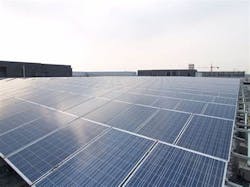The U.S. Solar Market Insight Q3 2022 report, by the Solar Energy Industries Association (SEIA) and Wood Mackenzie, expects the U.S. solar market to grow by 40% over baseline projections through 2027.
The growth will be supported by incentives and tax credits included within the recent Inflation Reduction Act (IRA).
“This report provides an early look at how the Inflation Reduction Act is going to transform America’s energy economy, and the forecasts show a wave of clean energy and manufacturing investments that will uplift communities nationwide,” said SEIA president and CEO Abigail Ross Hopper. “With this incredible opportunity comes a responsibility to clearly address concerns over forced labor and ensure that we have ethical supply chains throughout the world.”
Even as supply chain issues continue for the solar market, the Uyghur Forced Labor Prevention Act (UFLPA) took effect in June, exacerbating the challenges faced by the industry. The report states that the UFLPA can limit solar deployment through 2023 due to module availability constraints. The pause on new solar tariffs for two years provided some relief. Nevertheless, solar installation forecasts have declined to 15.7 GW, which is the lowest total since 2019.
Meanwhile, the IRA is expected to positively impact the solar market from 2024.
“The Inflation Reduction Act has given the solar industry the most long-term certainty it has ever had,” said Michelle Davis, principal analyst at Wood Mackenzie and lead author of the report. “Ten years of investment tax credits stands in stark contrast to the one-, two-, or five-year extensions that the industry has experienced in the last decade. It’s not an overstatement to say that the IRA will lead to a new era for the US solar industry.”
EnergyTech Upcoming Webinar on understanding and utilizing the IRA to create Clean Energy in your state
Sept. 27 free and open webinar: Now is the Moment: New Government Support for Climate Projects
Featuring government relations and project experts from Schneider Electric and EnergySage
Cumulative solar installations are expected to nearly triple from 129 GW today to 336 GW by 2027. Utility-scale solar is expected to lead the growth, with the addition of 162 GW of new capacity. The IRA will drive the addition of 7.3 GW of residential solar capacity.
Demand for rooftop solar is already at historic highs because of the challenges posed by power outages and rising electricity prices. A total of 1.36 GW was installed in the residential segment in the second quarter of 2022, up 37% over the second quarter of 2021 and up 7% over the first quarter of this year. California (459 MW), Florida (134 MW), and Texas (111 MW) led in terms of installations.
However, the overall U.S. solar market installed 4.6 GW of solar capacity, down 12% from the previous year and up 12% from the previous quarter. Commercial solar installed 336 MW, down 7% over the previous year and up 13% quarter-on-quarter. Community solar installations were down 15% year-over-year and down 2% quarter-over-quarter.
New York represented half of the installed community solar volume for the quarter, according to the report. The expectations for the community solar volumes for this year have increased over the previous outlook, up 18%, mainly due to healthy installation volumes in Maine and New York.





